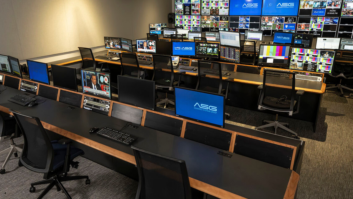
Elisabetta Romano has recently become head of TV and media at Ericsson. She spoke to TVBEurope about competition in the industry, her ten years at the company and plans to drive the business forward
Could you tell us what your vision for the industry is over the next five years?
We are all transitioning from the digital era of television into the internet era, which is already proving to be the most disruptive in the history of the industry. Content owners, broadcasters and TV service providers will all require different strategies for success but all will have to adapt and evolve in order to overcome a period of unprecedented change. We are entering a new golden media age for television, which will see today’s media value chain dismantled and re-set, bringing about the creation of a new, dynamic ecosystem. This will spark the arrival of new competitors to the industry. Former competitors will become allies and vice-versa.
With change comes opportunity. As we advance to 2020, we will see a fully advanced and fully connected TV market, driven almost exclusively by consumers and their demand for greater choice, better quality and superior methods of personalisation. There will be 26 billion connected devices plugged into a global IP network by 2020, of which a large proportion will be video enabled. Total mobile video traffic between 2015-2020 will be more than 22 times that of the period 2009-2014. Global brands will join with new consumer technologies, the world of apps and online experiences will expand and we will see the arrival of disruptive new business models that will overhaul the entire media landscape. While the future is unknown, the players with the greatest foresight, innovation and consumer focus will be best prepared to lead the industry over the next five years.
Competition within the industry has rapidly increased over recent years. What do you believe are the key disruptors in this shifting landscape?
Competition has increased for our customers through industry consolidation driving scale, and because lower barriers to entry for new OTT players bring aggressively differentiated consumer propositions. The continually shifting values and needs of the digital consumer are accelerating the demands placed upon those providing the best content and services. We are now in a position where the pace of change is so fast, consumer expectations are outpacing the industry’s ability to deliver them. They want to be able to view their content on any device, at any location and at any time.
Nevertheless, technology will be integral to satisfying these expectations. The role of IP will become an industry imperative, serving an ever increasing number of connected devices and delivering greater speed and immediacy which will be fundamental to implanting a unified user experience. 5G will be the next step in the evolution of mobile broadband and provide a watershed for delivering the flexibility, high reliability and responsiveness needed to deliver video to billions of users across the globe, and especially in enabling the on-demand transition in most emerging markets. LTE Broadcast is already showing its potential in making high capacity mobile networks ready for the video-first focus.
High Efficiency Video Coding (HEVC) will help to bridge the economic and technical bandwidth constraints of direct-to-consumer networks and help enable the delivery of Ultra High Definition (UHD) content. The introduction of HDR will also enable our industry to differentiate services with vibrant images on screen, providing content owners with the opportunity to create more compelling and more realistic experiences for viewers.
Ericsson has a broad range of customers across the TV and media industry. Will different businesses need to adopt different strategies to thrive?
Absolutely. Our Media Vision 2020 research highlights that the TV and media industry will be worth $750 billion within the next five years and as TV evolves, it is essential for every business to revaluate their strategies for success.
Content owners and broadcasters will continually build stronger direct-to-viewer platforms and propositions while seeking to still exploit the TV service provider channels to market. They will work to globalise their content brands and content distribution to drive revenues and scale. We see many of them re-investing in the production competence and rights, re-centering some of them solidly in the content itself.
TV service providers across cable and telecom will continue in the majority to seek to bundle multiple services and content together for consumers, to make their lives as simple as possible and drive as much ARPU potential as possible. It will take considerable platform re-engineering to be truly experience-led in what is offered to consumers. A huge opportunity ahead is to provide the most personalised content aggregation and recommendation towards consumers.
4K and UHD are extremely hot topics right now. How important are immersive experiences to the consumer of today and the future?
They are extremely important! With each shift in quality technique (analogue to digital, SD to HD, 3D to some extent, and now Ultra HD) viewers have embraced the enhancement and shown willingness to pay. Each advancement takes the viewer closer to real-life experiences and Ultra HD is like a big window into the world.
As a founding member of the Ultra HD Forum, Ericsson is investing broadly in R&D and thought leadership to educate the industry as much as possible around the possibilities inherent in Ultra HD and what we even mean by this. It has certainly been tied to resolution and ‘4K’ television, however, we also believe that High Dynamic Range (HDR) holds a lot of potential, as do higher frame rates and colour gamut.
But immersive TV is not just about picture quality; it is also about immersion of the content itself. Our ConsumerLab research shows how much consumers are binge viewing episodes they obsess over, which illustrates the immersion of on-demand access to shows. It also relates to augmenting content – our Piero software solution enables the most amazing sport graphics and innovations in enhancing the ultra premium sports experience.
In your new position at the helm of Ericsson’s TV and media solutions division, how do you plan to drive the business forward?
Ericsson is fully committed to the transformation of television and working with all of its customers ranging from content owners, broadcasters and TV service providers to enable their transformation. The TV consumer is already driving change for many in terms of their needs, values and demands. Our business strategy will centre on taking our unique insights of consumer and industry research, and combining these with an ever-expanding new software portfolio and the transformation services to enable our customers to harness the opportunities ahead.
For many content owners and broadcasters, achieving this seamless, unified viewing experience is going to involve forging ahead with over-the-top strategies; an area which we specialise in and foresee being a strong business driver as we head towards 2020.
For our TV service provider customers across cable, satellite and telecom, we will enable them to build next generation platforms on top of which they can be truly agile and innovate the experience of aggregations, search, recommendation and service bundling towards the consumer. For sure, cloud is a primary enabler here, as are all-IP delivery networks that address any screen on any network.
The key is to delight TV consumers every day. If our customers are doing this, enabled by us, we believe they will be the most successful.
You’ve been at Ericsson for over ten years now. What prior experience outside of the TV space will you bring to this role?
I’ve been with Ericsson since 2003, most recently leading the OSS (Operating Support Systems) and BSS (Business Support Systems) side of the business, which together connect operator networks to the customer. In this time I have built up an intricate understanding of the pressures facing operators in the Networked Society, and parallels with the TV and media industry are already apparent. Growth in data traffic is spiralling across both. Consumers are taking connectivity for granted across both, demanding more control and more personalised services. And when it comes to responding to these challenges, agility has simply become a market necessity.
I see a lot of potential in the proactive customer experience management innovations we drove within OSS/BSS and the more holistic approach we took to enabling agility in four ways. Customer agility is about taking big data and turning it into the personal touch, putting the customer in control and making sure they get the level of service they expect. Service agility means quickly turning their expectations into actual offerings and being able to monetise that dynamically. A major challenge exists in the area of network agility (or infrastructure agility), which involves transforming legacy systems into something more lightweight. Lastly, organisational agility requires the removal of siloes within these businesses, to create a seamless operation that aligns with third party players and so on.
While we outlined these elements to help operators understand the magnitude of change required to really transform and be agile, this philosophy holds as true to the telco world as it does the TV and media space. Only with the utmost agility can both operators and service providers respond to their customers’ needs, develop services rapidly and cost effectively, and successfully leverage external intelligence to extract value from the new digital economy.







